Statistics of Business & Finance: Stock Investment Recommendation
VerifiedAdded on 2022/11/13
|8
|1191
|326
Project
AI Summary
This project analyzes the risk and return characteristics of two stocks, GD and BA, using statistical methods. The analysis includes calculating stock returns, performing the Jarque-Bera test to assess normality, conducting hypothesis tests on average returns and variances, and constructing confidence intervals. The Capital Asset Pricing Model (CAPM) is employed to estimate the beta of GD stock. The project concludes with a comparison of the stocks based on risk and return, recommending GD as the preferred investment due to its lower risk profile despite similar returns. The student's analysis includes interpretation of statistical outputs, such as p-values and R-squared, to inform investment decisions.
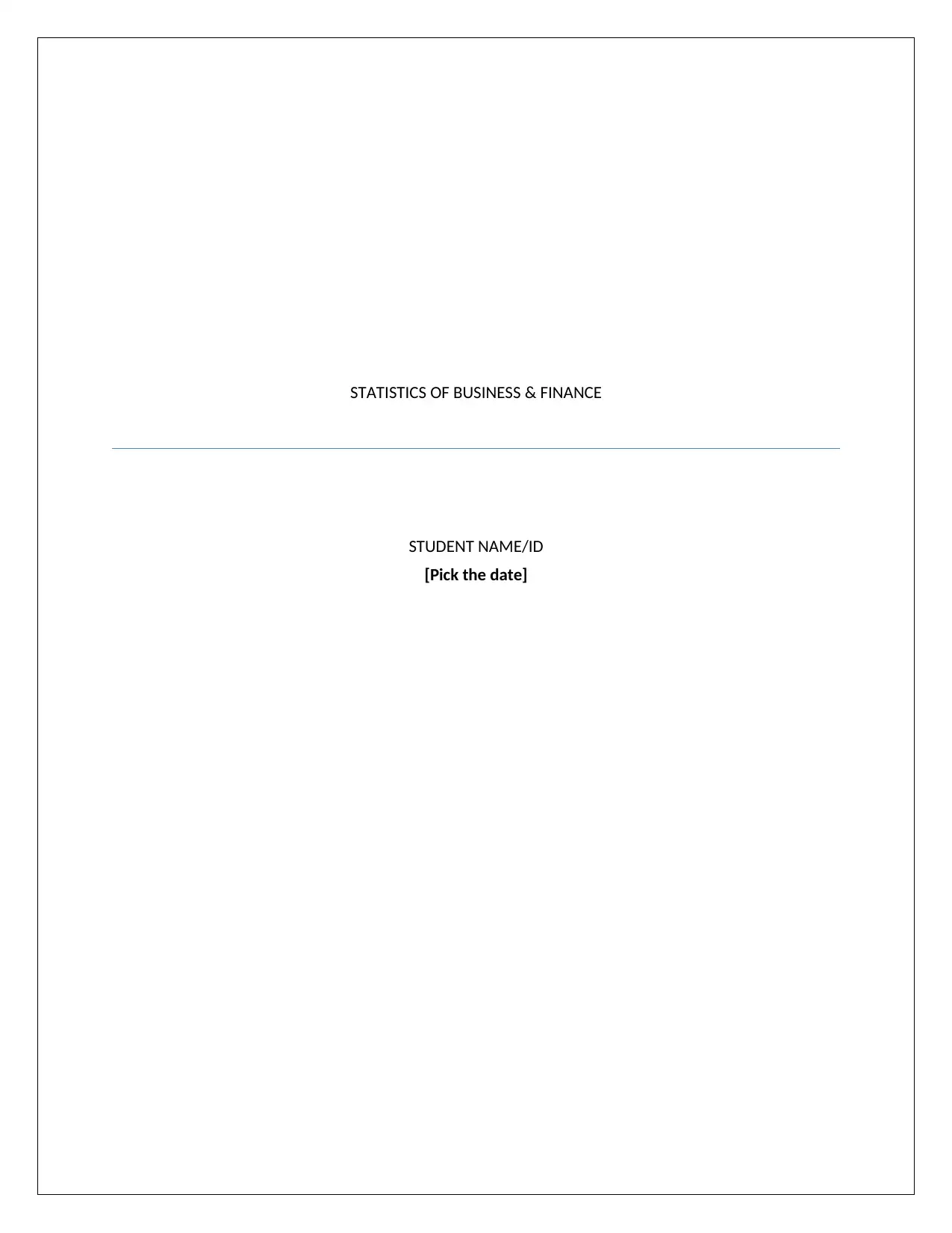
STATISTICS OF BUSINESS & FINANCE
STUDENT NAME/ID
[Pick the date]
STUDENT NAME/ID
[Pick the date]
Paraphrase This Document
Need a fresh take? Get an instant paraphrase of this document with our AI Paraphraser
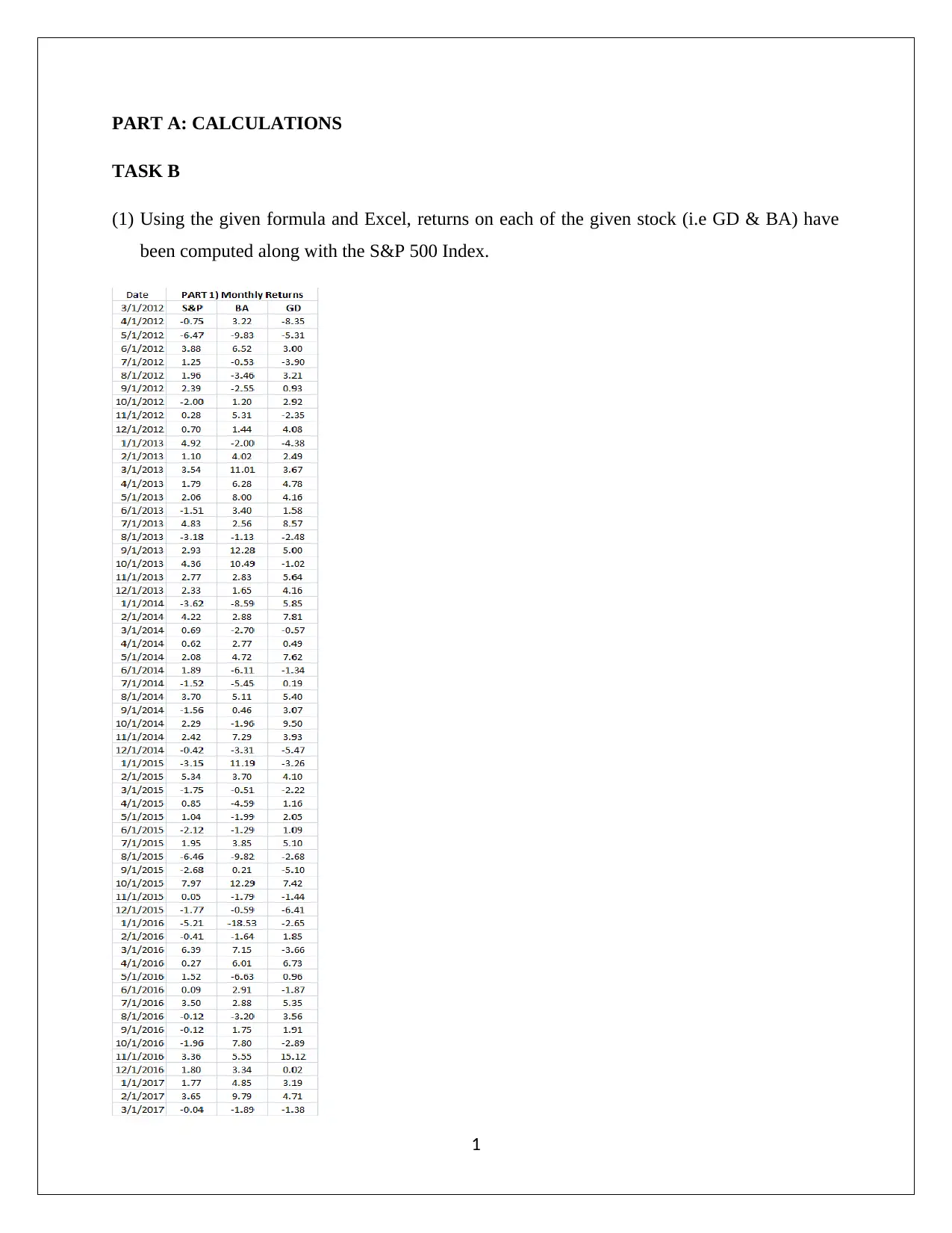
PART A: CALCULATIONS
TASK B
(1) Using the given formula and Excel, returns on each of the given stock (i.e GD & BA) have
been computed along with the S&P 500 Index.
1
TASK B
(1) Using the given formula and Excel, returns on each of the given stock (i.e GD & BA) have
been computed along with the S&P 500 Index.
1
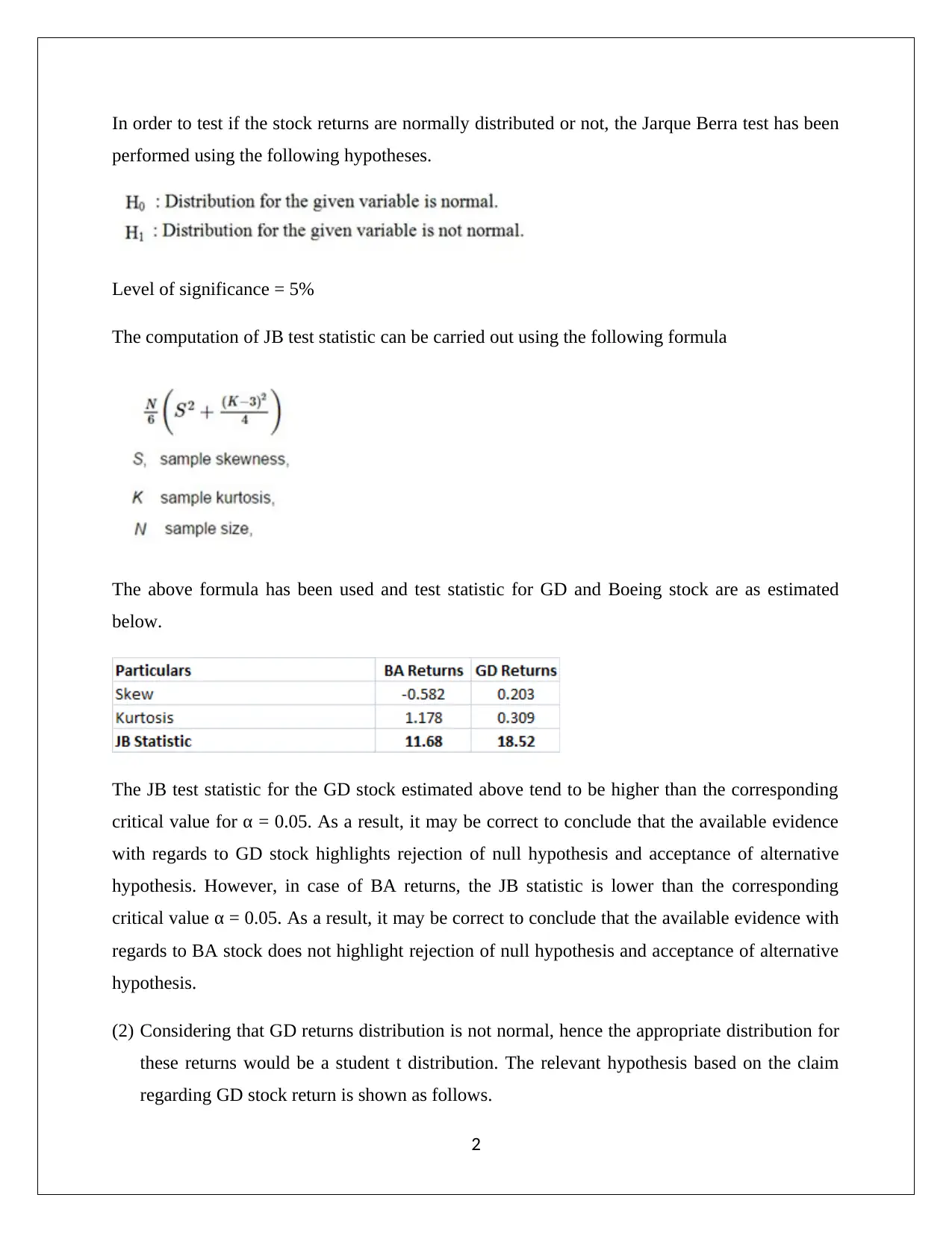
In order to test if the stock returns are normally distributed or not, the Jarque Berra test has been
performed using the following hypotheses.
Level of significance = 5%
The computation of JB test statistic can be carried out using the following formula
The above formula has been used and test statistic for GD and Boeing stock are as estimated
below.
The JB test statistic for the GD stock estimated above tend to be higher than the corresponding
critical value for α = 0.05. As a result, it may be correct to conclude that the available evidence
with regards to GD stock highlights rejection of null hypothesis and acceptance of alternative
hypothesis. However, in case of BA returns, the JB statistic is lower than the corresponding
critical value α = 0.05. As a result, it may be correct to conclude that the available evidence with
regards to BA stock does not highlight rejection of null hypothesis and acceptance of alternative
hypothesis.
(2) Considering that GD returns distribution is not normal, hence the appropriate distribution for
these returns would be a student t distribution. The relevant hypothesis based on the claim
regarding GD stock return is shown as follows.
2
performed using the following hypotheses.
Level of significance = 5%
The computation of JB test statistic can be carried out using the following formula
The above formula has been used and test statistic for GD and Boeing stock are as estimated
below.
The JB test statistic for the GD stock estimated above tend to be higher than the corresponding
critical value for α = 0.05. As a result, it may be correct to conclude that the available evidence
with regards to GD stock highlights rejection of null hypothesis and acceptance of alternative
hypothesis. However, in case of BA returns, the JB statistic is lower than the corresponding
critical value α = 0.05. As a result, it may be correct to conclude that the available evidence with
regards to BA stock does not highlight rejection of null hypothesis and acceptance of alternative
hypothesis.
(2) Considering that GD returns distribution is not normal, hence the appropriate distribution for
these returns would be a student t distribution. The relevant hypothesis based on the claim
regarding GD stock return is shown as follows.
2
⊘ This is a preview!⊘
Do you want full access?
Subscribe today to unlock all pages.

Trusted by 1+ million students worldwide
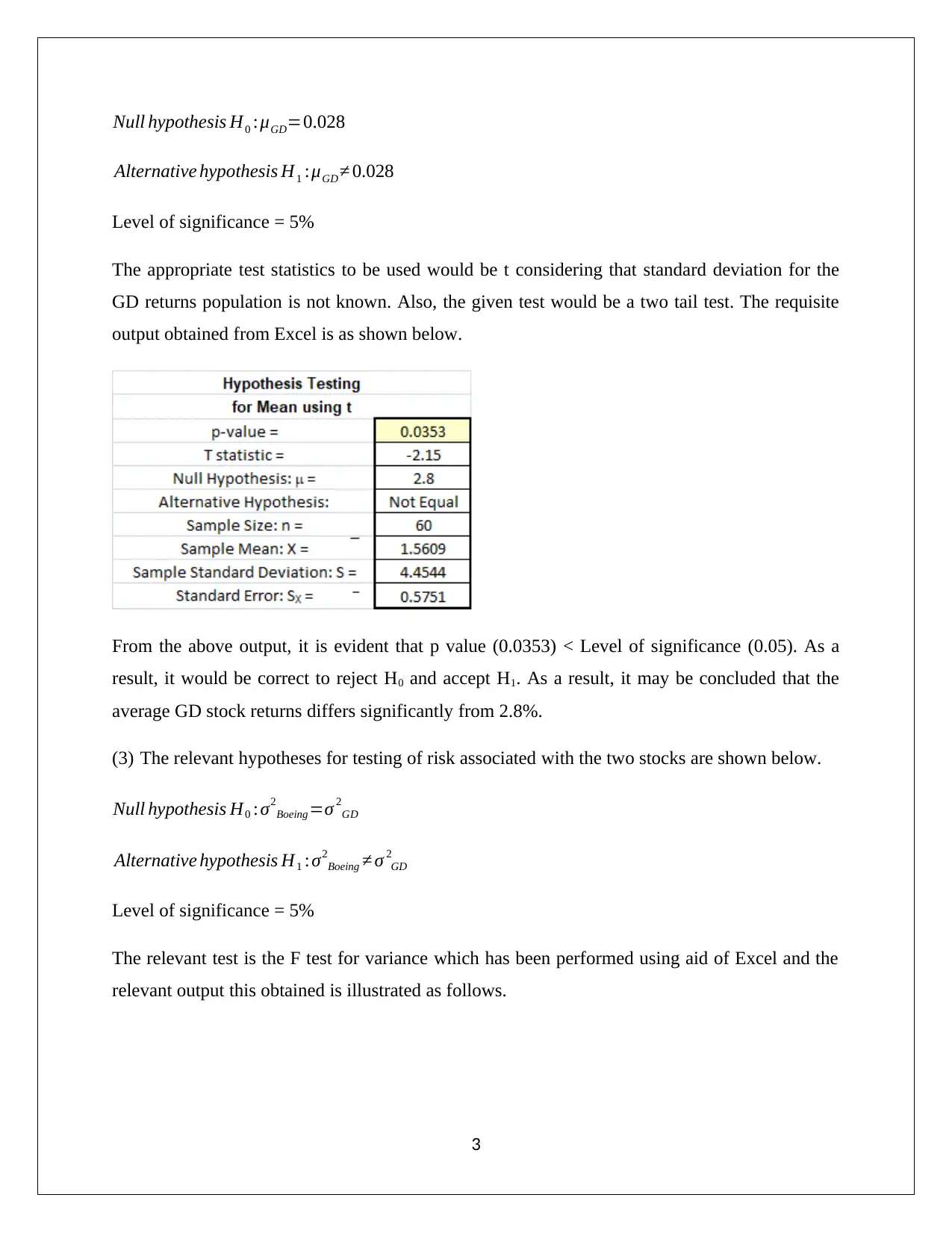
Null hypothesis H0 :μGD=0.028
Alternative hypothesis H1 :μGD≠ 0.028
Level of significance = 5%
The appropriate test statistics to be used would be t considering that standard deviation for the
GD returns population is not known. Also, the given test would be a two tail test. The requisite
output obtained from Excel is as shown below.
From the above output, it is evident that p value (0.0353) < Level of significance (0.05). As a
result, it would be correct to reject H0 and accept H1. As a result, it may be concluded that the
average GD stock returns differs significantly from 2.8%.
(3) The relevant hypotheses for testing of risk associated with the two stocks are shown below.
Null hypothesis H0 :σ2
Boeing =σ 2
GD
Alternative hypothesis H1 :σ2
Boeing ≠ σ 2
GD
Level of significance = 5%
The relevant test is the F test for variance which has been performed using aid of Excel and the
relevant output this obtained is illustrated as follows.
3
Alternative hypothesis H1 :μGD≠ 0.028
Level of significance = 5%
The appropriate test statistics to be used would be t considering that standard deviation for the
GD returns population is not known. Also, the given test would be a two tail test. The requisite
output obtained from Excel is as shown below.
From the above output, it is evident that p value (0.0353) < Level of significance (0.05). As a
result, it would be correct to reject H0 and accept H1. As a result, it may be concluded that the
average GD stock returns differs significantly from 2.8%.
(3) The relevant hypotheses for testing of risk associated with the two stocks are shown below.
Null hypothesis H0 :σ2
Boeing =σ 2
GD
Alternative hypothesis H1 :σ2
Boeing ≠ σ 2
GD
Level of significance = 5%
The relevant test is the F test for variance which has been performed using aid of Excel and the
relevant output this obtained is illustrated as follows.
3
Paraphrase This Document
Need a fresh take? Get an instant paraphrase of this document with our AI Paraphraser
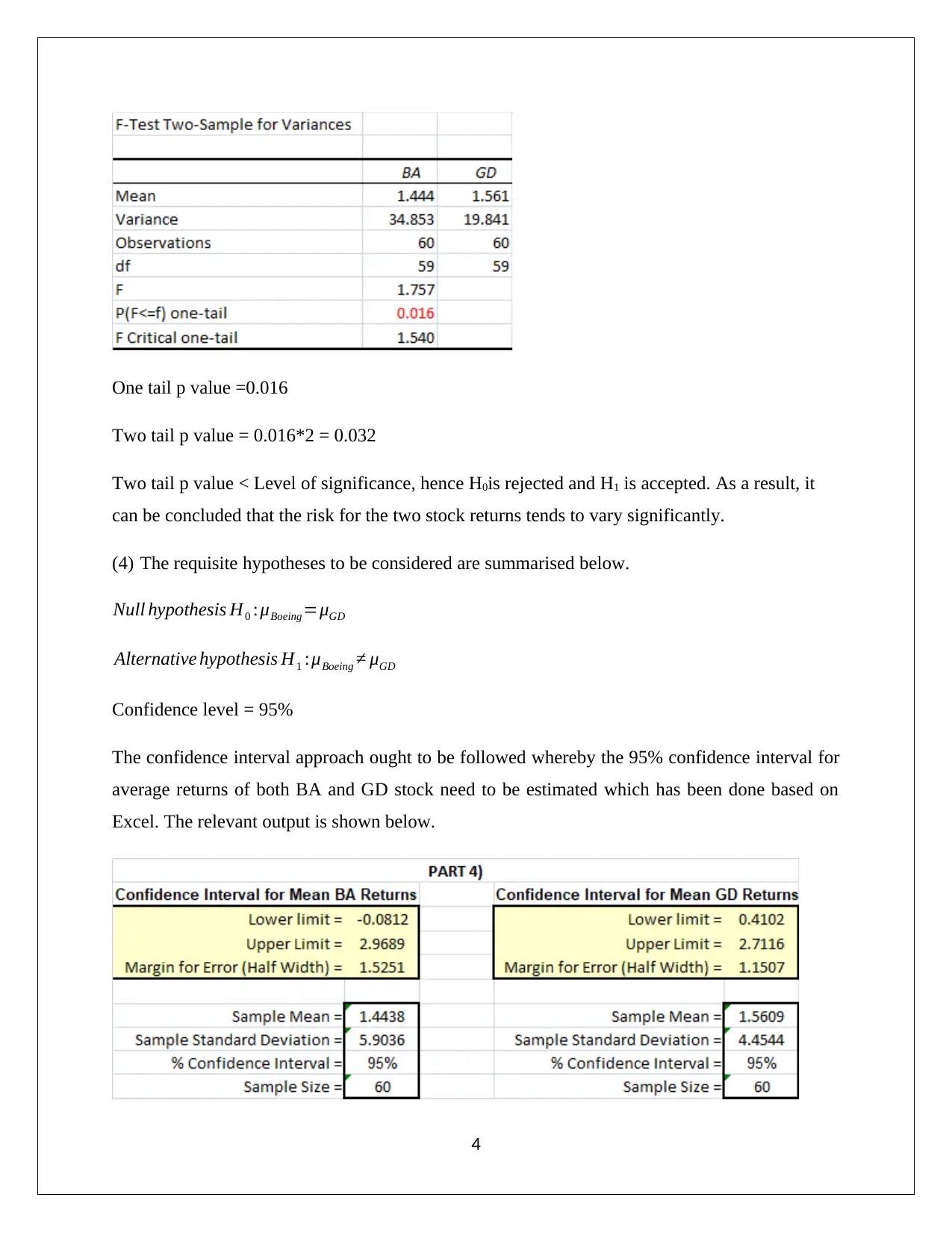
One tail p value =0.016
Two tail p value = 0.016*2 = 0.032
Two tail p value < Level of significance, hence H0is rejected and H1 is accepted. As a result, it
can be concluded that the risk for the two stock returns tends to vary significantly.
(4) The requisite hypotheses to be considered are summarised below.
Null hypothesis H0 :μBoeing =μGD
Alternative hypothesis H1 :μBoeing ≠ μGD
Confidence level = 95%
The confidence interval approach ought to be followed whereby the 95% confidence interval for
average returns of both BA and GD stock need to be estimated which has been done based on
Excel. The relevant output is shown below.
4
Two tail p value = 0.016*2 = 0.032
Two tail p value < Level of significance, hence H0is rejected and H1 is accepted. As a result, it
can be concluded that the risk for the two stock returns tends to vary significantly.
(4) The requisite hypotheses to be considered are summarised below.
Null hypothesis H0 :μBoeing =μGD
Alternative hypothesis H1 :μBoeing ≠ μGD
Confidence level = 95%
The confidence interval approach ought to be followed whereby the 95% confidence interval for
average returns of both BA and GD stock need to be estimated which has been done based on
Excel. The relevant output is shown below.
4
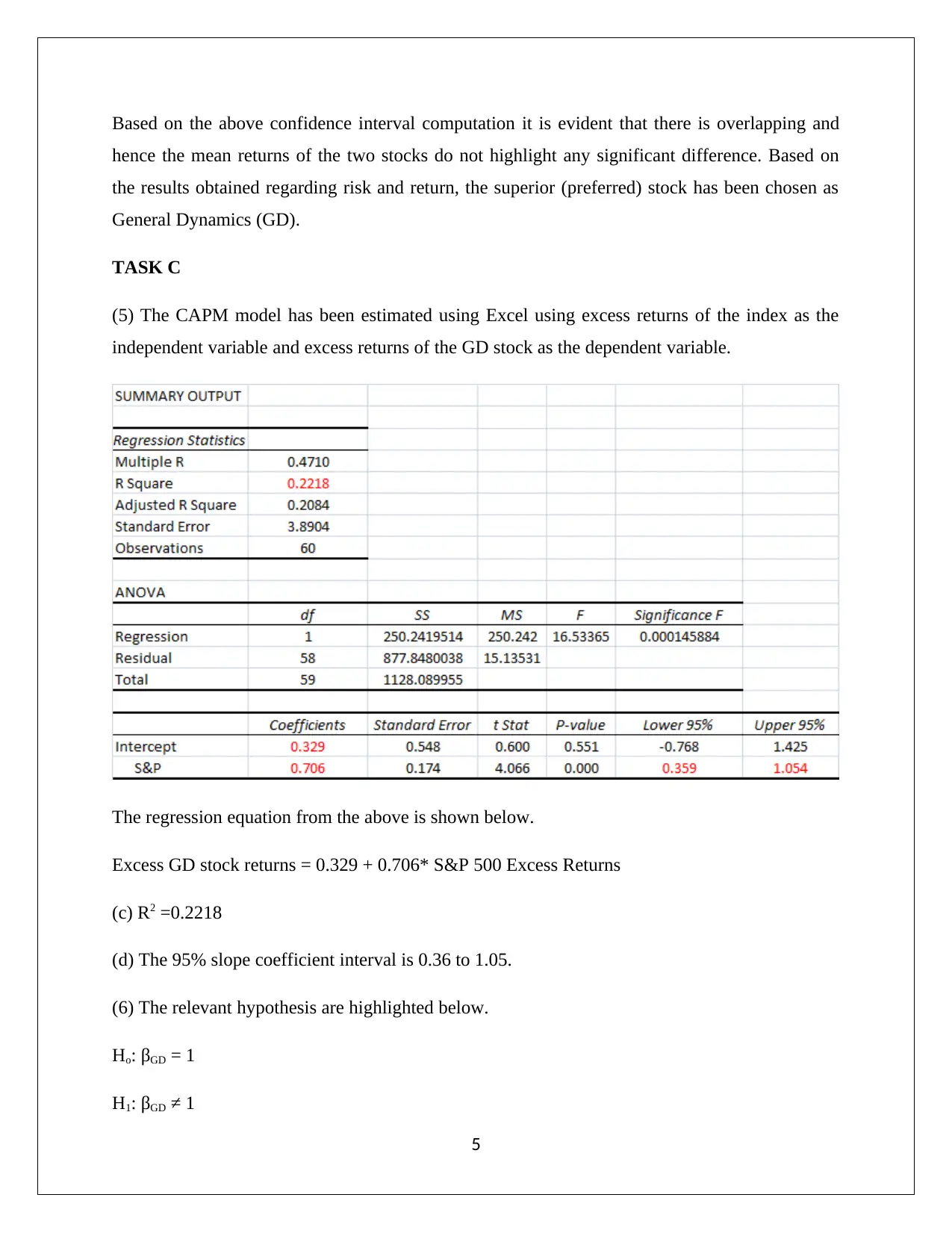
Based on the above confidence interval computation it is evident that there is overlapping and
hence the mean returns of the two stocks do not highlight any significant difference. Based on
the results obtained regarding risk and return, the superior (preferred) stock has been chosen as
General Dynamics (GD).
TASK C
(5) The CAPM model has been estimated using Excel using excess returns of the index as the
independent variable and excess returns of the GD stock as the dependent variable.
The regression equation from the above is shown below.
Excess GD stock returns = 0.329 + 0.706* S&P 500 Excess Returns
(c) R2 =0.2218
(d) The 95% slope coefficient interval is 0.36 to 1.05.
(6) The relevant hypothesis are highlighted below.
Ho: βGD = 1
H1: βGD ≠ 1
5
hence the mean returns of the two stocks do not highlight any significant difference. Based on
the results obtained regarding risk and return, the superior (preferred) stock has been chosen as
General Dynamics (GD).
TASK C
(5) The CAPM model has been estimated using Excel using excess returns of the index as the
independent variable and excess returns of the GD stock as the dependent variable.
The regression equation from the above is shown below.
Excess GD stock returns = 0.329 + 0.706* S&P 500 Excess Returns
(c) R2 =0.2218
(d) The 95% slope coefficient interval is 0.36 to 1.05.
(6) The relevant hypothesis are highlighted below.
Ho: βGD = 1
H1: βGD ≠ 1
5
⊘ This is a preview!⊘
Do you want full access?
Subscribe today to unlock all pages.

Trusted by 1+ million students worldwide
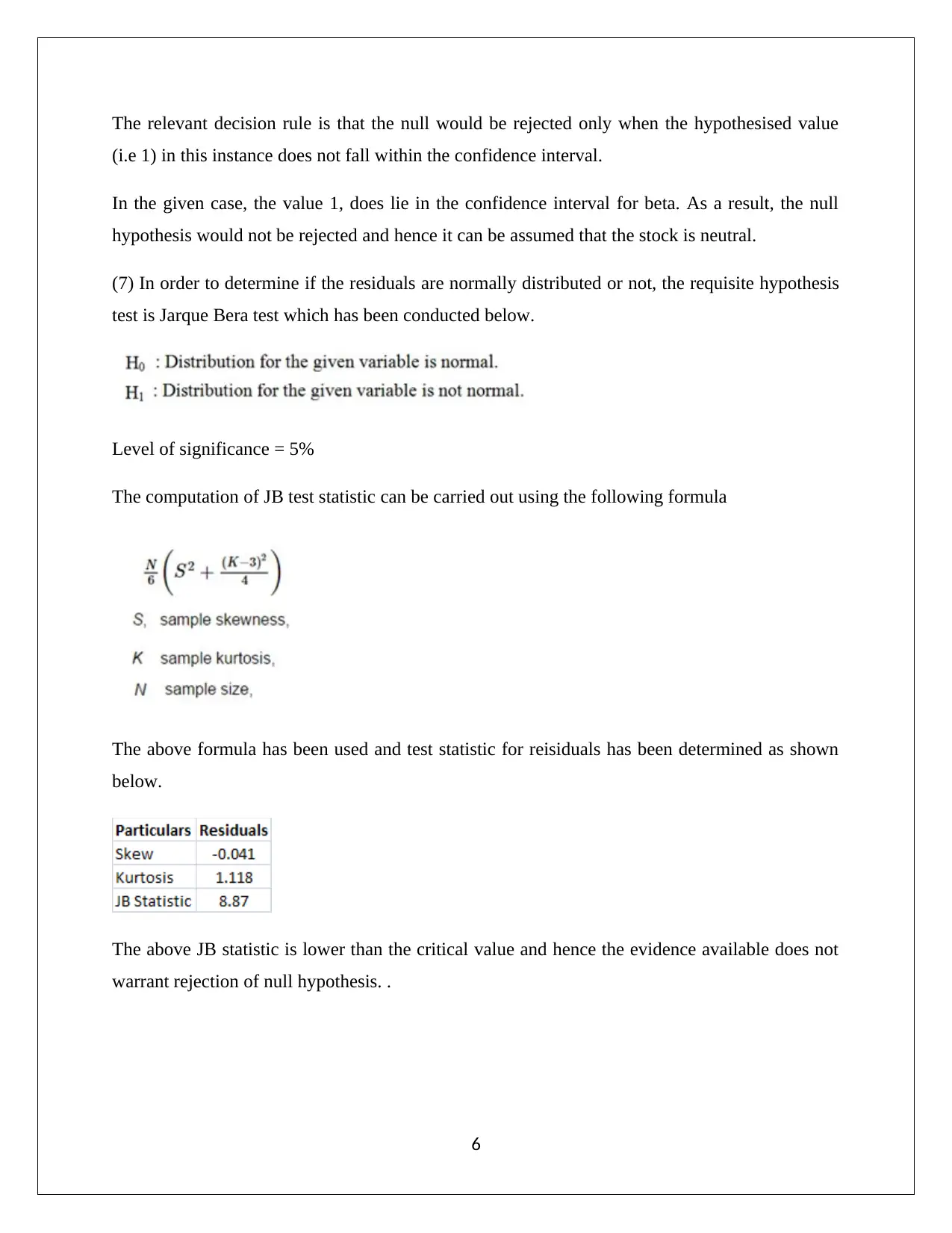
The relevant decision rule is that the null would be rejected only when the hypothesised value
(i.e 1) in this instance does not fall within the confidence interval.
In the given case, the value 1, does lie in the confidence interval for beta. As a result, the null
hypothesis would not be rejected and hence it can be assumed that the stock is neutral.
(7) In order to determine if the residuals are normally distributed or not, the requisite hypothesis
test is Jarque Bera test which has been conducted below.
Level of significance = 5%
The computation of JB test statistic can be carried out using the following formula
The above formula has been used and test statistic for reisiduals has been determined as shown
below.
The above JB statistic is lower than the critical value and hence the evidence available does not
warrant rejection of null hypothesis. .
6
(i.e 1) in this instance does not fall within the confidence interval.
In the given case, the value 1, does lie in the confidence interval for beta. As a result, the null
hypothesis would not be rejected and hence it can be assumed that the stock is neutral.
(7) In order to determine if the residuals are normally distributed or not, the requisite hypothesis
test is Jarque Bera test which has been conducted below.
Level of significance = 5%
The computation of JB test statistic can be carried out using the following formula
The above formula has been used and test statistic for reisiduals has been determined as shown
below.
The above JB statistic is lower than the critical value and hence the evidence available does not
warrant rejection of null hypothesis. .
6
Paraphrase This Document
Need a fresh take? Get an instant paraphrase of this document with our AI Paraphraser
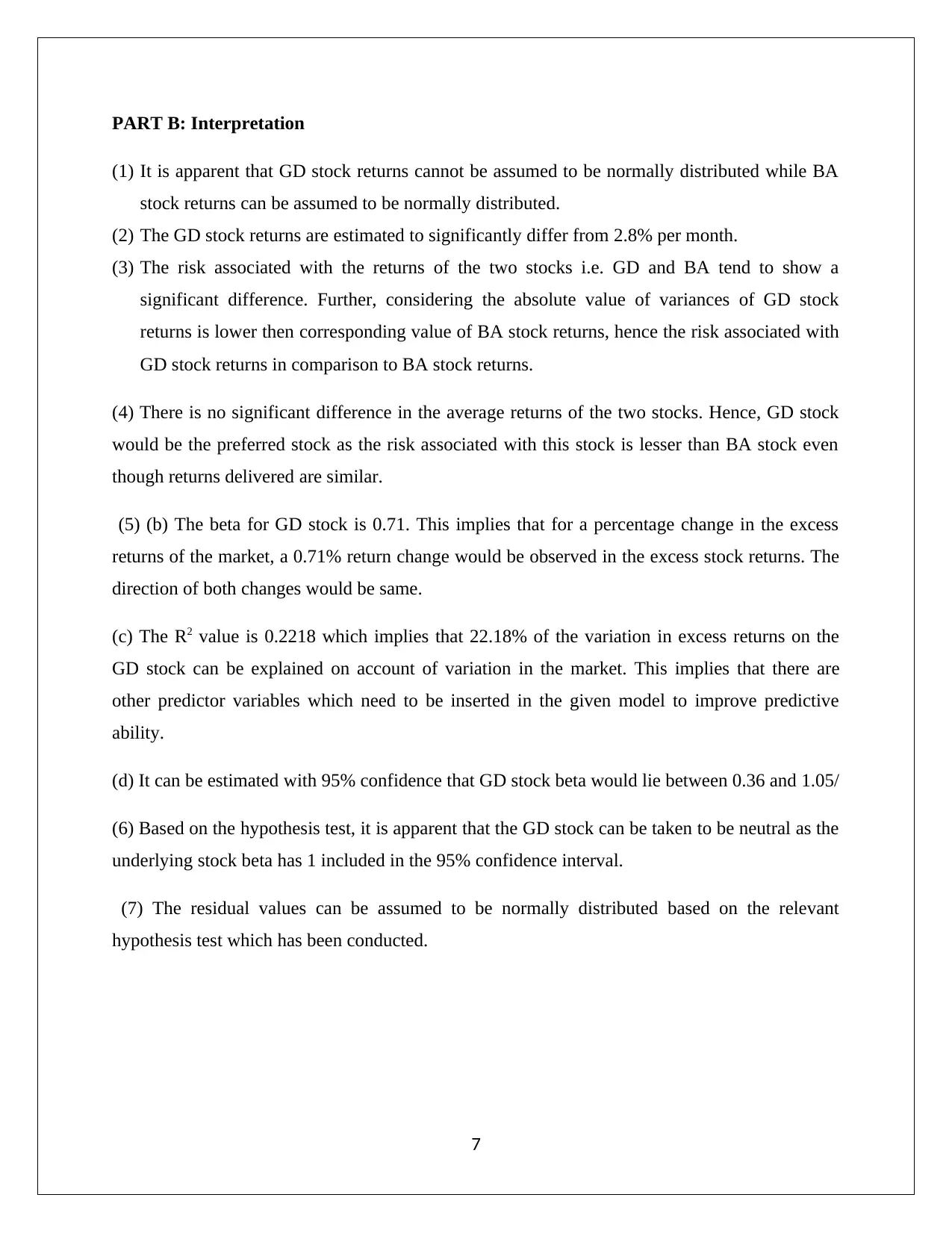
PART B: Interpretation
(1) It is apparent that GD stock returns cannot be assumed to be normally distributed while BA
stock returns can be assumed to be normally distributed.
(2) The GD stock returns are estimated to significantly differ from 2.8% per month.
(3) The risk associated with the returns of the two stocks i.e. GD and BA tend to show a
significant difference. Further, considering the absolute value of variances of GD stock
returns is lower then corresponding value of BA stock returns, hence the risk associated with
GD stock returns in comparison to BA stock returns.
(4) There is no significant difference in the average returns of the two stocks. Hence, GD stock
would be the preferred stock as the risk associated with this stock is lesser than BA stock even
though returns delivered are similar.
(5) (b) The beta for GD stock is 0.71. This implies that for a percentage change in the excess
returns of the market, a 0.71% return change would be observed in the excess stock returns. The
direction of both changes would be same.
(c) The R2 value is 0.2218 which implies that 22.18% of the variation in excess returns on the
GD stock can be explained on account of variation in the market. This implies that there are
other predictor variables which need to be inserted in the given model to improve predictive
ability.
(d) It can be estimated with 95% confidence that GD stock beta would lie between 0.36 and 1.05/
(6) Based on the hypothesis test, it is apparent that the GD stock can be taken to be neutral as the
underlying stock beta has 1 included in the 95% confidence interval.
(7) The residual values can be assumed to be normally distributed based on the relevant
hypothesis test which has been conducted.
7
(1) It is apparent that GD stock returns cannot be assumed to be normally distributed while BA
stock returns can be assumed to be normally distributed.
(2) The GD stock returns are estimated to significantly differ from 2.8% per month.
(3) The risk associated with the returns of the two stocks i.e. GD and BA tend to show a
significant difference. Further, considering the absolute value of variances of GD stock
returns is lower then corresponding value of BA stock returns, hence the risk associated with
GD stock returns in comparison to BA stock returns.
(4) There is no significant difference in the average returns of the two stocks. Hence, GD stock
would be the preferred stock as the risk associated with this stock is lesser than BA stock even
though returns delivered are similar.
(5) (b) The beta for GD stock is 0.71. This implies that for a percentage change in the excess
returns of the market, a 0.71% return change would be observed in the excess stock returns. The
direction of both changes would be same.
(c) The R2 value is 0.2218 which implies that 22.18% of the variation in excess returns on the
GD stock can be explained on account of variation in the market. This implies that there are
other predictor variables which need to be inserted in the given model to improve predictive
ability.
(d) It can be estimated with 95% confidence that GD stock beta would lie between 0.36 and 1.05/
(6) Based on the hypothesis test, it is apparent that the GD stock can be taken to be neutral as the
underlying stock beta has 1 included in the 95% confidence interval.
(7) The residual values can be assumed to be normally distributed based on the relevant
hypothesis test which has been conducted.
7
1 out of 8
Related Documents
Your All-in-One AI-Powered Toolkit for Academic Success.
+13062052269
info@desklib.com
Available 24*7 on WhatsApp / Email
![[object Object]](/_next/static/media/star-bottom.7253800d.svg)
Unlock your academic potential
Copyright © 2020–2025 A2Z Services. All Rights Reserved. Developed and managed by ZUCOL.


